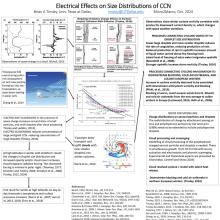Electrical Effects on Cloud Microphysics: Large Scale Influence
Brian
Tinsley
University of Texas at Dallas
Poster
The top-down electrical influence on clouds that is clearest comes from the global atmospheric electric circuit, via the downward ionosphere-earth current density JZ. This passes through clouds and is present all over the globe as a few picoamps per square meter. It is modulated at about the10% level by the solar wind.
From Ohm’s law the value of Jz is the difference in potential between the ionosphere and the Earth’s surface (~250 kV, produced by thunderstorms) divided by the column resistance R (averaging about 10^17, ohm m ^-2) that depends on ionization by galactic cosmic rays (GCRs).
The electric field in the solar wind produces ionospheric potential changes ~20 kV from the magnetic poles out to about 15⁰ co-magnetic latitude on the day-to-day and 27-day timescales. The magnetic field in the solar wind modulates the GCR flux and R out to about 40⁰ magnetic co-latitude by about the same percentage, on the day-to-day (Forbush decrease); decadal; bi-decadal; and century (200-400 yr) timescales. As Jz flows through clouds it redistributes the electric charge to produce positive space charge near cloud tops and negative space charge near cloud bases.
Correlations of cloud opacity and cloud cover and atmospheric dynamics with such Jz changes are observed on all the above timescales. The day-to-day and bi-decadal correlations are unique to the Jz forcing. The alternative attribution of the decadal and century timescale forcing, due to solar UV and stratospheric ozone changes possibly affecting tropospheric dynamics, cannot be ruled out, but has not been successfully validated by models.
Tinsley, B. A., 2023. Solar Activity, Weather and Climate, the Elusive Connection, Bull. Am. Meteorol. Soc, Sept. 2023. https://doi.org/10.1175/BAMS-D-23-0065.1
Harrison, R. G., and Lockwood, M., 2020. Rapid indirect solar responses observed in the lower atmosphere, Proc. Roy. Soc., 476A,20200164, https://doi.org/10.1098/rspa.2020.0164
From Ohm’s law the value of Jz is the difference in potential between the ionosphere and the Earth’s surface (~250 kV, produced by thunderstorms) divided by the column resistance R (averaging about 10^17, ohm m ^-2) that depends on ionization by galactic cosmic rays (GCRs).
The electric field in the solar wind produces ionospheric potential changes ~20 kV from the magnetic poles out to about 15⁰ co-magnetic latitude on the day-to-day and 27-day timescales. The magnetic field in the solar wind modulates the GCR flux and R out to about 40⁰ magnetic co-latitude by about the same percentage, on the day-to-day (Forbush decrease); decadal; bi-decadal; and century (200-400 yr) timescales. As Jz flows through clouds it redistributes the electric charge to produce positive space charge near cloud tops and negative space charge near cloud bases.
Correlations of cloud opacity and cloud cover and atmospheric dynamics with such Jz changes are observed on all the above timescales. The day-to-day and bi-decadal correlations are unique to the Jz forcing. The alternative attribution of the decadal and century timescale forcing, due to solar UV and stratospheric ozone changes possibly affecting tropospheric dynamics, cannot be ruled out, but has not been successfully validated by models.
Tinsley, B. A., 2023. Solar Activity, Weather and Climate, the Elusive Connection, Bull. Am. Meteorol. Soc, Sept. 2023. https://doi.org/10.1175/BAMS-D-23-0065.1
Harrison, R. G., and Lockwood, M., 2020. Rapid indirect solar responses observed in the lower atmosphere, Proc. Roy. Soc., 476A,20200164, https://doi.org/10.1098/rspa.2020.0164

Tinsley-Brian-Poster1.pdf
(1.16 MB)
Meeting homepage
